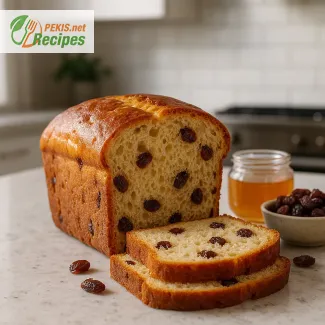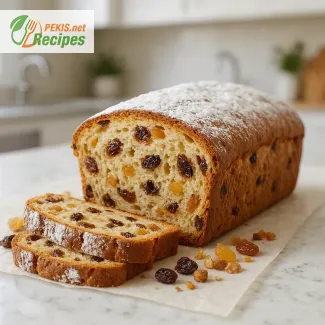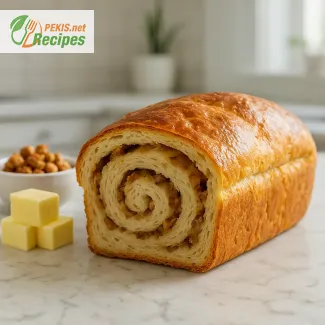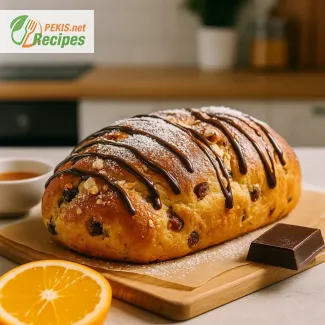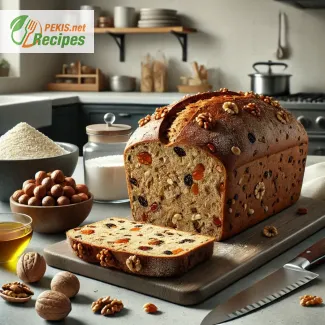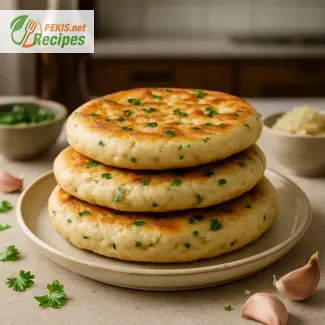Makes 10 slices, prep 30 min, bake 30 min, total 60 min. The Tangzhong bread technique creates an exceptionally soft and fluffy loaf with a light crumb and long-lasting freshness. Made with simple ingredients like flour, milk, butter, egg, and yeast, it rises beautifully and delivers bakery-quality results at home. Perfect for sandwiches, toast, or rolls, it keeps fresh for 2 days at room temperature or up to 2 months frozen, and reheats at 150 °C for 8–10 minutes.
PEKIS – professional chef and recipe developer with more than 25 years of experience, specialized in European and international cuisine. For this Tangzhong bread, I’ve drawn on years of working with enriched doughs and traditional Asian baking techniques, adapting them for everyday kitchens. My focus was on creating a loaf that’s not only light and fluffy but also easy to reproduce at home, with a balance of flavor and texture that stays fresh longer.

Soft and airy Tangzhong method for homemade bread
The secret technique behind fluffy loaves with long-lasting freshness
The Tangzhong method, often called the water roux technique, transforms ordinary bread into an exceptionally soft, fluffy, and moist loaf that stays fresh longer than standard homemade bread. By cooking a portion of flour and liquid into a smooth paste before mixing it into the dough, the process changes the way starch absorbs water. The result is a bread with a tender crumb, elastic texture, and the kind of lightness usually found in professional bakery loaves.
Originating in East Asia and gaining worldwide recognition, Tangzhong became especially popular in Japanese milk bread, where its signature pillowy texture turned it into a global favorite. Today, bakers use this technique in both traditional loaves and creative variations, from sandwich bread to sweet rolls. Its versatility makes it a staple for anyone seeking the perfect balance of flavor, texture, and structure in homemade bread.
Why this recipe stands out
- Soft crumb with structure – each slice is tender yet holds its shape.
- Stays fresh longer – the moisture-retaining roux delays staling.
- Beginner-friendly technique – straightforward method with professional results.
- Versatile base – works for sandwich loaves, rolls, or filled breads.
- Beautiful oven spring – the dough rises high and bakes evenly.
Key elements that shape the Tangzhong experience
When flour and liquid are cooked into a smooth roux, the starch gelatinizes, locking in extra moisture. This simple preparation impacts every stage of baking:
- The dough is easier to knead, more elastic, and less sticky.
- The yeast works efficiently, producing a consistent rise.
- The baked loaf remains airy, even after cooling.
- The flavor develops fully, with a subtle sweetness and delicate aroma.
These combined effects make Tangzhong bread not only a pleasure to eat but also practical for everyday use. Families appreciate how well it slices for sandwiches, toasts evenly, and maintains freshness without added preservatives.
Creative variations with Tangzhong
The technique adapts to multiple bread styles and flavor additions:
- Sweet milk bread – enriched with butter and milk for a dessert-like softness.
- Whole grain loaves – blending whole wheat or rye while maintaining a light texture.
- Stuffed rolls – filled with chocolate, jam, or savory fillings.
- Artisan-style loaves – combined with sourdough starter for complexity.
Bakers often experiment by incorporating herbs, seeds, or spices directly into the dough. The Tangzhong base ensures that even creative variations stay light and enjoyable.
Storage and make-ahead preparation
- Room temperature: keeps well in an airtight container for up to 2 days.
- Freezing: freeze whole loaves or slices for up to 2 months.
- Reheating: warm in the oven at 150 °C (300 °F) for 8–10 minutes to restore softness.
This flexibility makes it easy to prepare in advance, ensuring freshly baked bread is always within reach.
Practical insights for bakers
- Milk in the dough enriches the flavor and contributes to a silky texture.
- Butter adds richness and keeps the crumb tender.
- Sugar not only sweetens but also supports fermentation and browning.
- Yeast activates more efficiently thanks to the Tangzhong’s hydration.
Each ingredient benefits from the water roux base, amplifying the final loaf’s softness and resilience.
Why you will love this Tangzhong bread
- Light and fluffy texture that feels bakery-quality.
- Ideal for sandwiches, toast, or as a side to meals.
- Flexible base for both sweet and savory versions.
- Simple technique that elevates everyday baking.
- Make the Tangzhong: In a saucepan, whisk flour with water and milk. Cook over medium heat, stirring constantly until it thickens into a smooth paste. Remove from heat and let it cool to room temperature.
- Mix the dough: In a large bowl, combine flour, sugar, salt, and yeast. Add cooled Tangzhong, egg, milk, and softened butter. Mix until the dough starts to form.
- Knead: Transfer the dough to a lightly floured surface and knead for 10–15 minutes until smooth and elastic.
- First rise: Place the dough in a greased bowl, cover, and let rise for about 1 hour or until doubled in size.
- Shape the loaf: Punch down the dough, divide into equal parts, and shape into rolls or a single loaf. Place in a greased loaf pan.
- Second rise: Cover and let rise again for 40–50 minutes until puffy.
- Bake: Preheat oven to 180 °C (350 °F). Bake for 25–30 minutes until golden brown on top.
- Cool: Remove from oven, brush with melted butter if desired, and let cool before slicing.
FAQ questionWhat is Tangzhong and why does it make bread softer?
Tangzhong is a water roux made by cooking a small portion of flour with liquid until the starch gelatinizes. This lets the dough hold more moisture, leading to a soft, fluffy crumb, better oven spring, and slower staling. You’ll notice slices that stay tender for days and toast evenly without drying out.
FAQ questionHow much flour and liquid should I use for the Tangzhong?
Use about 5–10% of the total flour for the roux and cook it with 5× its weight in liquid (a 1:5 flour-to-liquid ratio by weight). Heat to around 65 °C (149 °F), stirring until it becomes a smooth paste. Cool to room temperature before adding to the dough so the yeast isn’t stressed.
FAQ questionCan I use bread flour or whole wheat with Tangzhong?
Yes. With bread flour (higher protein), you’ll get a bit more chew and structure; with all-purpose flour, the crumb is extra tender. For whole wheat, start by replacing 20–30% of the white flour and add 10–20 ml extra liquid if the dough feels tight. Tangzhong helps lighten whole-grain loaves, keeping them moist without heaviness.
FAQ questionHow do I know the dough is kneaded and proofed enough?
Knead until it’s smooth, elastic, and can pass a windowpane test (a thin, translucent film without tearing). For fermentation, go by the dough, not the clock: bulk-rise until doubled, and final proof until the dough is puffy and a gentle poke springs back slowly. Proper gluten development plus correct proofing equals a tall, airy loaf.
FAQ questionWhy did my Tangzhong loaf turn dense or dry?
Likely causes: under-kneading, under- or over-proofing, dough too cool, weak yeast, or too much flour from heavy dusting. Fixes: knead to full elasticity, proof to the right visual cues, keep dough around 24–26 °C, use fresh yeast, measure ingredients by weight, and resist adding extra flour unless the dough is truly sticky.
FAQ questionCan I make it without egg or dairy?
Yes. For dairy-free, swap milk with oat or soy milk and butter with plant butter or neutral oil (expect a slightly different richness). For egg-free, use 7 g ground flax + 45 ml water (rest 10 minutes) or 45 g aquafaba. Tangzhong maintains softness even with these substitutions, though flavor and browning may shift slightly.
FAQ questionWhat’s the difference between Tangzhong and Yudane?
Tangzhong cooks flour and liquid to about 65 °C, used the same day, yielding a very soft, pillowy crumb. Yudane scalds flour with boiling water, rests overnight, and tends to produce a slightly chewier texture with a subtly different flavor. Both extend freshness; choose based on the crumb you prefer.
A loaf made with the Tangzhong method delivers more than softness – it brings a consistency that feels reliable in every bake. The gentle roux base captures moisture, protecting the crumb from drying out and ensuring each slice stays light and fluffy for days. Bakers who seek a dependable everyday bread find that this method creates results usually reserved for professional kitchens.
The balance of milk, butter, flour, and yeast is elevated through Tangzhong’s unique process. By modifying the dough structure early on, the bread develops a natural elasticity that makes kneading easier and shaping smoother. The final loaf rises beautifully, with a golden crust and a pillowy center that’s ideal for both sandwiches and toast.
Practicality makes this approach even more appealing. Tangzhong bread can be stored at room temperature for two days, frozen for two months, and reheated to restore its original softness. This flexibility supports modern home baking, where convenience matters as much as tradition.
Beyond its technical value, Tangzhong has become a symbol of cross-cultural baking. From its roots in Asian cuisine to its growing place in European and American kitchens, it represents how simple techniques can connect traditions and inspire creativity. The method adapts easily to sweet rolls, enriched doughs, and even whole-grain blends, proving its role as a versatile foundation for countless variations.
Choosing to master Tangzhong means choosing bread that combines flavor, freshness, and texture in one harmonious loaf. It’s a method that rewards both beginners and experienced bakers, offering a pathway to bread that looks beautiful, tastes satisfying, and lasts longer than most homemade recipes.
Allergens present in the recipe
- Gluten (from flour)
- Dairy (milk, butter)
- Egg
Substitution tips to remove allergens
- Replace regular flour with certified gluten-free bread flour mix.
- Replace cow’s milk with soy milk or oat milk.
- Replace butter with dairy-free margarine or coconut oil.
- Omit egg or use flaxseed meal mixed with water as an egg replacement.
- Vitamin B1 (Thiamine): 0.2 mg – supports energy metabolism
- Vitamin B2 (Riboflavin): 0.1 mg – essential for cell function
- Vitamin B3 (Niacin): 2 mg – contributes to healthy digestion
- Vitamin B9 (Folate): 35 µg – important for red blood cell formation
- Calcium: 35 mg – supports bone strength
- Iron: 2 mg – essential for oxygen transport
- Magnesium: 20 mg – helps muscle and nerve function
- Potassium: 90 mg – maintains fluid balance
- Selenium 12 µg – protects cells from oxidative stress
- Vitamin E 0.4 mg – contributes to skin and immune health
- Lutein + Zeaxanthin 35 µg – supports eye health
